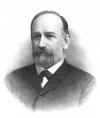Biography
Joseph Stefan (Slovene: Jo?ef ?tefan) was a Carinthian Slovene physicist, mathematician, and poet of Austrian citizenship.
Life and work
Stefan was born in an outskirt village St Peter (Slovene Sveti Peter) near Ebenthal (Slovene ?relec) (today a district of Klagenfurt) (Celovec) in the Austrian Empire (now in Austria) to father Ale? (Aleksander) Stefan, born in 1805 and mother Marija Startinik, born 1815. His parents, both ethnic Slovenes, were married when Jo?ef was eleven. The Stefans were a modest family. His father was a milling assistant and mother served as a maidservant. Stefan's father died in 1872 while his mother died almost ten years earlier in 1863. Stefan attended elementary school in Klagenfurt, where he showed his talent. They recommended that he continue his schooling, so in 1845 he went to Klagenfurt gymnasium. He experienced the revolutionary year of 1848, as a thirteen-year-old boy, which inspired him to be sympathetic toward Slovene literary production. After having graduated top of his class in high school he briefly considered joining the Benedictine order but his great interest in physics prevailed. He left for Vienna in 1853 to study mathematics and physics. His professor of physics in gymnasium was Karel Robida who wrote the first Slovene physics textbook. Stefan then graduated in mathematics and physics at the University of Vienna in 1857.
During his student years, he also wrote and published a number of poems in Slovene. He taught physics at the University of Vienna, was Director of the Physical Institute from 1866, Vice-President of the Vienna Academy of Sciences and member of several scientific institutions in Europe. He published nearly 80 scientific articles, mostly in the Bulletins of the Vienna Academy of Sciences, and he is best known for originating a physical power law in 1879 stating that the total radiation from a black body j is proportional to the fourth power of its thermodynamic temperature. This law was mathematically derived from the measurements of French physicists Dulong and Petit. As both incident radiation and blackbody emission are always equal, this equation applies equally to the temperature of any ideal body subject to incident radiation across its surface. In 1884 the law was extended to apply to grey-body emissions by Stefan's student Ludwig Boltzmann and hence is known as the Stefan-Boltzmann law. Boltzmann treated a heat engine with light as a working matter. This law is the only physical law of nature named after a Slovene physicist. Today we derive the law from Planck's law of black body radiation. With his law Stefan determined the temperature of the Sun's surface and he calculated a value of 5430 °C. This was the first sensible value for the temperature of the Sun. Stefan provided the first measurements of the thermal conductivity of gases, treated evaporation, and among others studied diffusion, heat conduction in fluids. For his treatise on optics he received the Richard Lieben award from the University of Vienna. Flow from a droplet or particle that is induced by evaporation or sublimation at the surface is now called Stefan flow because of his early work in calculating evaporation and diffusion rates. Very important are also his electromagnetic equations, defined in vector notation, and works in the kinetic theory of heat. He was among the first physicists in Europe who fully understood Maxwell's electromagnetic theory and one of the few outside of England who expanded on it. He calculated inductivity of a coil with a quadratic cross-section, and he corrected Maxwell's miscalculation. He also researched a phenomenon called the skin effect, where high-frequency electric current is greater on the surface of a conductor than in its interior. In mathematics the Stefan problems or Stefan's tasks with movable boundary are well known. The problem was first studied by Lamé and Clapeyron in 1831. Stefan solved the problem when he was calculating how quickly a layer of ice on water grows. He died in Vienna, Austria-Hungary. His life and work is extensively studied by the physicist Janez Strnad.
Eponymous terms
In physics, several concepts are named after Joseph Stefan. In particular
Stefan-Boltzmann law
Stefan-Boltzmann constant s
Stefan problem
Stefan's equation
Stefan's formula
Stefan flow
Stefan number
Stefan's force
The Jo?ef Stefan Institute was also named after him. ..






